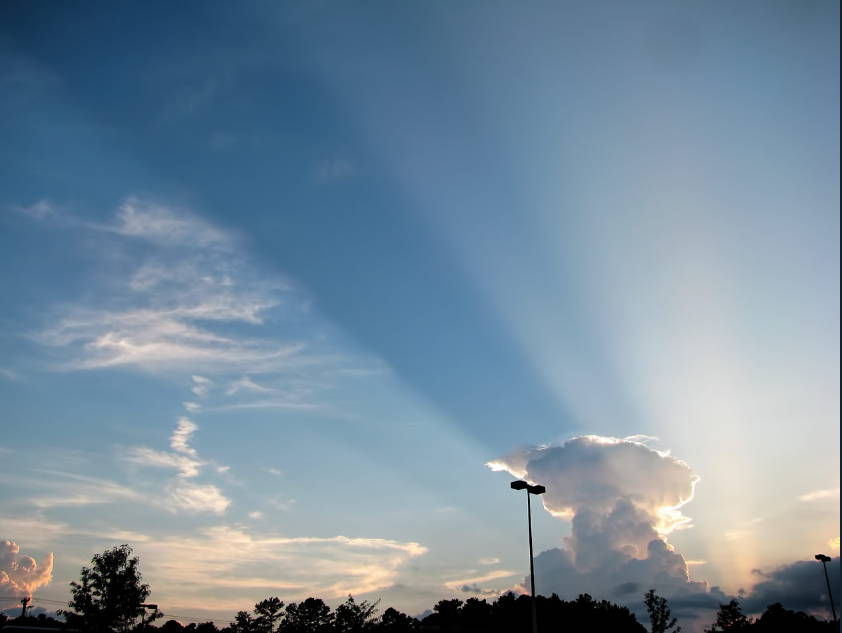Cloud shadows and Mini Moon - OPOD
Cloud Shadows and Mini Moon - A Captivating Atmospheric Phenomenon
Cloud shadows are a fascinating atmospheric phenomenon that often goes unnoticed amidst the hustle and bustle of our daily lives. These transient shadows, cast by clouds onto the Earth's surface, create a mesmerizing interplay between light and darkness. Coupled with the presence of a mini moon, these spectacles can truly captivate our imagination and remind us of the wonders that surround us in the sky.
The moon, despite being a mere 2160 miles in diameter, holds a special place in our hearts. We often hear about "supermoons" when it appears larger in the sky due to its proximity to Earth during its orbit perigee. However, in reality, the moon is always a diminutive object in the vast expanse above us. Its small size becomes strikingly apparent when juxtaposed with the grandeur of a cloud shadow.
Imagine gazing at the sky and witnessing a cloud shadow gracefully traversing its celestial canvas. Such was the experience of Tom Faber, who captured an awe-inspiring image of a cloud shadow near Roswell, Georgia, USA. In his photograph, the mini moon is overshadowed by the immense expanse of the cloud shadow, which stretches towards the antisolar point - the point opposite to the position of the sun.
The lunar phase, just a few days past first quarter, further reinforces the direction from which the shadow originates. It confirms that our view is directed away from the sun. Looking sunward, we can observe the shadow's source emanating from towering cumulus clouds situated approximately 48 kilometers away. The sheer distance covered by this cloud formation emphasizes the scale and magnitude of this atmospheric interplay.
Cloud shadows and mini moons are not commonly discussed atmospheric phenomena, but they offer a unique opportunity to appreciate the intricate dance between light and shadow in our skies. To delve deeper into this captivating topic, let's explore some key aspects:
1. The Formation of Cloud Shadows
- Cloud shadows are formed when sunlight passes through gaps in the cloud cover and casts a shadow on the Earth's surface.
- The varying thickness and density of clouds influence the intensity and shape of these shadows.
- As clouds move across the sky, their shadows glide across the landscape, creating an ever-changing play of light and darkness.
2. Anticrepuscular Rays
- In conjunction with cloud shadows, anticrepuscular rays often accompany this atmospheric spectacle.
- Anticrepuscular rays are parallel beams of sunlight that appear to converge at the antisolar point, opposite to the position of the sun.
- These rays, visible as streaks of light in the sky, add an ethereal touch to the scene, enhancing its visual allure.
3. Mini Moons and their Visual Impact
- Mini moons, also known as micromoons, occur when the moon is at its farthest point from Earth during its orbit apogee.
- Due to their distance, mini moons appear smaller in the sky compared to when they are closer during a supermoon.
- The juxtaposition of a mini moon with a cloud shadow creates a visually striking contrast, emphasizing the moon's diminutive size.
4. Lunar Phases and Viewing Direction
- Observing the lunar phase can provide valuable insights into the direction from which the cloud shadow originates.
- A crescent or gibbous moon indicates a viewing direction away from the sun, allowing us to witness the captivating interplay between the cloud shadow and the mini moon.
5. Satellite and Radar Imagery
- Advanced satellite and radar technologies allow us to estimate the distance and scale of cloud formations that cast these captivating shadows.
- By analyzing these images, scientists can gain a deeper understanding of the atmospheric conditions that contribute to the formation and movement of cloud shadows.
6. Appreciating Nature's Beauty
- Cloud shadows and mini moons serve as a reminder of the enchanting beauty that surrounds us in the natural world.
- By taking a moment to observe and appreciate these atmospheric phenomena, we can cultivate a deeper connection with the wonders of our universe.
In conclusion, cloud shadows and mini moons offer a captivating glimpse into the interplay between light, shadow, and celestial bodies. These transient spectacles remind us of the vastness of our atmosphere and the intricate beauty that unfolds above us. So, the next time you find yourself gazing at the sky, take a moment to appreciate the dance between clouds, shadows, and the diminutive yet mesmerizing mini moon.

Mini-Moon, Huge All-Sky Shadow
Tom Faber imaged this cloud shadow crossing the sky near Roswell, Georgia, USA. Images ©Tom Faber, shown with permission.
We hear much of 'super-moons' when the moon is largest in the sky at its orbit perigee. But our companion 2160 mile diameter ball of stone is in reality always a diminutive object in the sky. Here it is dwarfed by a cloud shadow/anticrepuscular ray plunging downwards toward the antisolar point. The lunar phase, a few days past first quarter, confirms that the viewing direction is away from the sun. The sunward view below shows the shadow emanating from towering cumulus estimated from satellite and radar images to be ~48km distant..

Note: this article has been automatically converted from the old site and may not appear as intended. You can find the original article here.
Reference Atmospheric Optics
If you use any of the definitions, information, or data presented on Atmospheric Optics, please copy the link or reference below to properly credit us as the reference source. Thank you!
-
<a href="https://atoptics.co.uk/blog/cloud-shadows-and-mini-moon-opod/">Cloud shadows and Mini Moon - OPOD</a>
-
"Cloud shadows and Mini Moon - OPOD". Atmospheric Optics. Accessed on November 26, 2024. https://atoptics.co.uk/blog/cloud-shadows-and-mini-moon-opod/.
-
"Cloud shadows and Mini Moon - OPOD". Atmospheric Optics, https://atoptics.co.uk/blog/cloud-shadows-and-mini-moon-opod/. Accessed 26 November, 2024
-
Cloud shadows and Mini Moon - OPOD. Atmospheric Optics. Retrieved from https://atoptics.co.uk/blog/cloud-shadows-and-mini-moon-opod/.